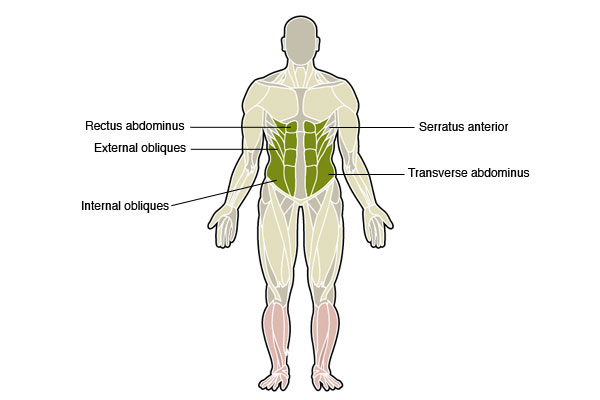Abs Training Explained
There's more to getting great abs than simply banging out crunches. Here's everything you need to know to reveal your six-pack

In This Series
- Introduction
- How to do the perfect crunch
Here at Men’s Fitness the question we are asked most frequently is “How can I get a six-pack?” The abdominals are the Top Trump trophy muscles – but that doesn't mean they're just for show. Our obsession with abs is justified because they are essential for making us fitter, stronger and faster. The abs may have come to symbolise masculinity but they also hold the key to beating your personal bests, whether you're in the park or the gym.
What do the abs do?
The name abs causes some confusion. Although they are almost always referred to in the plural, and they look like a group of muscles, the abs consist of a single sheet that connects the top of your pelvic bone to the bottom of your ribcage. Hard connective tissue marks out eight segments, forming a visible six-pack (or eight-pack, if you're lucky). On each side of your abs are your obliques, which are their supporting wings.
But the abs are only part of the story – they're the standard bearer for the group of muscles that make up the flexible, powerful midsection of your body called the core. Every time you activate a large muscle group you also activate the core so that it can stabilise your body and provide a solid platform from which your strength can operate. During sport the core acts as an energy pipeline, transmitting the force you generate with one half of your body into the other – why else would you rotate your shoulders and arms just before you kick a football?
You can help to train your core for stability by replacing the weight bench you use for weightlifting with a Swiss ball, and by doing exercises such as shoulder presses and biceps curls while standing up. Having to stabilise yourself on a Swiss ball forces the muscles to work harder than they would if they were supported by a solid object such as a bench.
Six-pack science
If you want to build an impressive six-pack, you'll need to crank out at least 1,500 crunches a week, right? Actually, no. We all have a six-pack underneath our body fat because our abs are crisscrossed by connective tissue that makes them look as if they're made up of separate segments. In order to make your six-pack more defined you have to increase the size of these muscle segments. To do this, the basic principles of weight training apply.
You need to exhaust your abs by lifting a heavy load in a short, intense workout. You should then allow at least 48 hours for them to recover and grow before their next workout. You should also eat 1.5g-2g of lean protein per kilogram of your bodyweight as part of your normal diet when building muscle. Once you've built some muscular endurance in your abs with normal crunches, you need to add some extra resistance by holding a medicine ball, weight plate or dumbbell across your chest.
This approach will develop the muscle underneath your layer of belly fat, but the fat itself will remain. Crunches or sit-ups alone will never burn off your beer belly. In fact, scientists with far too much time on their hands at the University of Virginia worked out that it would take 250,000 crunches to burn one pound of lard, by which time you would probably have died of boredom anyway.
In any case, this pound of fat would be taken from your entire body, not just the area around your abs. You can't burn fat from around your middle simply by working a specific area of your body, and it takes a significant overall reduction in your body fat percentage to uncover your abs. The only way to achieve this is still the old-fashioned way, with cardiovascular exercise.
Before you sign up for a marathon bear in mind that short, intense cardio workouts are better at torching calories and are less likely to burn off muscle. In fact, three 30-minute sessions per week of short-burst, intense cardio (combined with a diet low in saturated fat and processed carbs) can control body fat. Try repeating a cycle of one-minute flat-out bursts followed by one-minute rests.
How to get great abs
While abs-specific training is essential for building a six-pack, you shouldn't get fixated on a favourite exercise or work this area exclusively. Because the abs are so large, it's important to use exercises that work the lower, upper and side portions of your abs. You will provide your abs with a fresher challenge and improve their condition faster by hitting them from different angles and even working their opposite number in your lower back. This ensures that you make even strength gains, protecting you against injury and making your whole body fitter. Try these abs exercises and abs workouts for starters.
The pay-off
Striving for that six-pack doesn't have to be a slog. If you provide your abs with new challenges every four weeks, stick to healthy eating habits and don't neglect your other workouts, you'll soon see results. And because of the vital role your abs play in keeping your body stable, you'll take the physical challenges of everyday life in your stride. All you have to do is get out of that chair and move your midriff.
Get the Coach Newsletter
Sign up for workout ideas, training advice, reviews of the latest gear and more.
